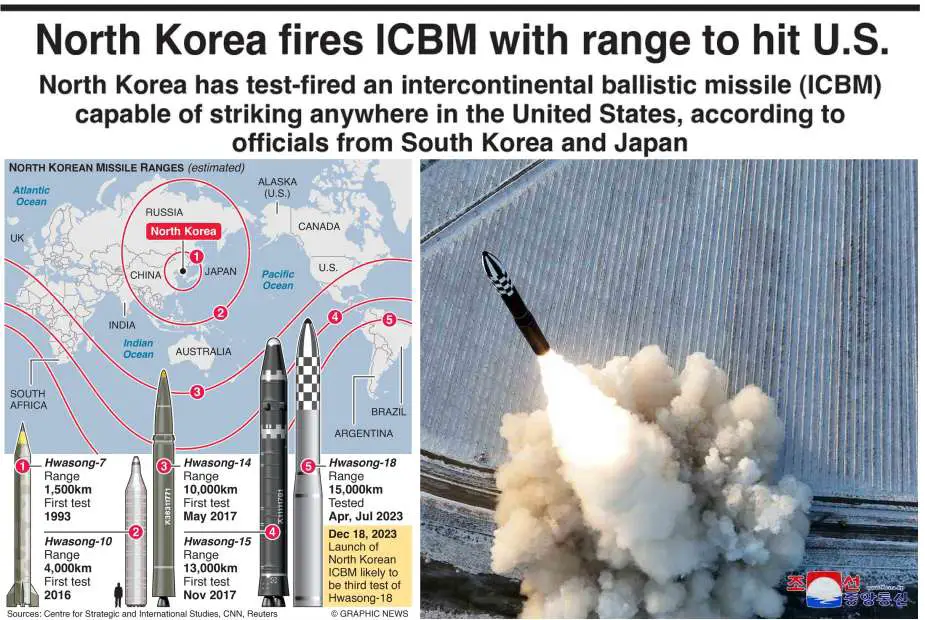Breaking news
Explained: How North Korea's Hwasong-18 ICBM Missile Can Reach the Heart of the US.
On December 18, 2023, North Korea made a strong message with the third launch of its Hwasong-18 missile. The missile reached a maximum altitude of over 6,000 km before falling into the sea west of Hokkaido, outside Japan's exclusive economic zone. The escalation of North Korea's intercontinental ballistic missile (ICBM) program represents a major turning point in global security dynamics. The Hwasong-14, Hwasong-15, and the recent Hwasong-18 missiles are at the heart of this growing concern, due to their extended range and destructive potential, all capable of striking US territory.
Follow Army Recognition on Google News at this link

The Hwasong-14, Hwasong-15, and the recent Hwasong-18 missiles are all capable of striking US territory. (Picture source: GraphicNews)
On December 18, 2023, a Hwasong-18 missile was launched for the third time by North Korea from an area near Pyongyang, heading towards the sea along the country's east coast. According to South Korea's Joint Chiefs of Staff, the missile traveled about 1,000 km. Japan's Ministry of Defense indicated that the flight lasted 73 minutes, almost equivalent to the 74-minute flight of an intercontinental ballistic missile (ICBM) launched by North Korea in July. The missile reached a maximum altitude of over 6,000 km before falling into the sea west of Hokkaido, outside Japan's exclusive economic zone.
This story reminds us of the relentless development of North Korean missiles over several years. However, the threat grows along with the range of the different North Korean missiles. But what are the real capabilities of these different missiles capable of striking deep into US soil?
First, there is the Hwasong-14, or KN-20, North Korea's first mobile intercontinental ballistic missile. Its first flight test took place on July 4, 2017, coinciding with the United States' Independence Day. This missile has a range that potentially puts it within reach of Alaska and Hawaii. During its tests, the Hwasong-14 reached an apogee of 3,724.9 km and covered a distance of 998 km in the Sea of Japan. If launched on an optimized trajectory, its range could extend up to 10,000 km, thus putting the west coast of the United States, Chicago, and possibly New York within its reach, albeit with a reduced payload for the North Korean missiles.
The Hwasong-15, designated KN-22 by the United States, is an advancement over the Hwasong-14. Launched for the first time on November 29, 2017, this missile is larger and has a more spacious payload fairing, allowing for the deployment of large nuclear warheads or multiples. It has been tested several times, reaching an apogee of 6,000 km and covering a distance of 1,080 km. North Korea claims that this missile is capable of striking the entire American continent.
The Hwasong-18 is the latest of the North Korean ICBMs, described as a solid-fuel missile, more difficult to detect by surveillance systems. In its last "launch exercise," it reached a maximum altitude of 6,518.2 km and covered a distance of 1,002.3 km. This test demonstrated its ability to strike anywhere in the continental United States.
If North Korea were to launch a nuclear attack against the United States, it would result in massive destruction in the targeted areas. Nuclear explosions would cause immense and immediate damage, destroying infrastructure, and causing countless human losses and serious injuries. Beyond the initial impact, the long-term effects would also be catastrophic. Radioactive fallout could contaminate vast areas, making the affected zones uninhabitable for many years and seriously affecting the environment and public health.
Moreover, such an act would likely trigger a massive military response from the United States and its allies, leading to a potentially global conflict. The geopolitical and economic repercussions would be immense, disrupting the world order, financial markets, and global supply chains.
Furthermore, the use of nuclear weapons would have profound psychological consequences on global populations, reinforcing fear and uncertainty about international security and stability. This could also trigger a nuclear arms race or encourage other states to develop or acquire nuclear weapons, thereby increasing the risks of nuclear proliferation.
As for the interception capabilities of the United States, it is a complex subject. Although the United States has developed advanced missile defense systems, the effectiveness of these systems against ICBMs like the Hwasong series is not absolute. Factors such as the missile's trajectory, speed, payload, and countermeasures like decoys can affect the success rate of interception. However, the Patriots present in Ukraine have managed to intercept, on several occasions, Russian ICBMs, suggesting that the United States might have the means to intercept ICBMs heading toward its territory.
The development of these missiles by North Korea represents a significant escalation of its military capabilities, posing a direct challenge to global security and stability, particularly concerning the United States. The technical advancements of these missiles, such as increased range and payload capacity, coupled with the challenges they pose to missile defense systems, underline the complexity and urgency of developing concrete solutions capable of intercepting any type of ICBM.


























